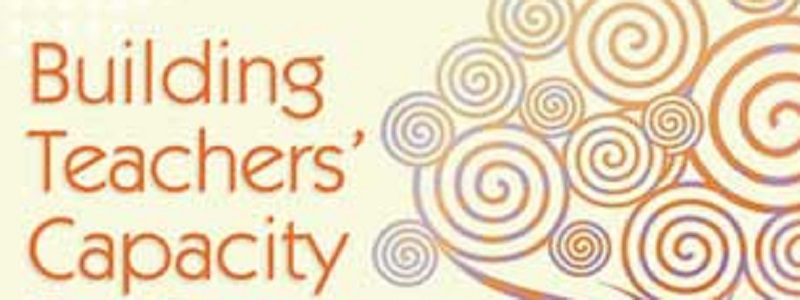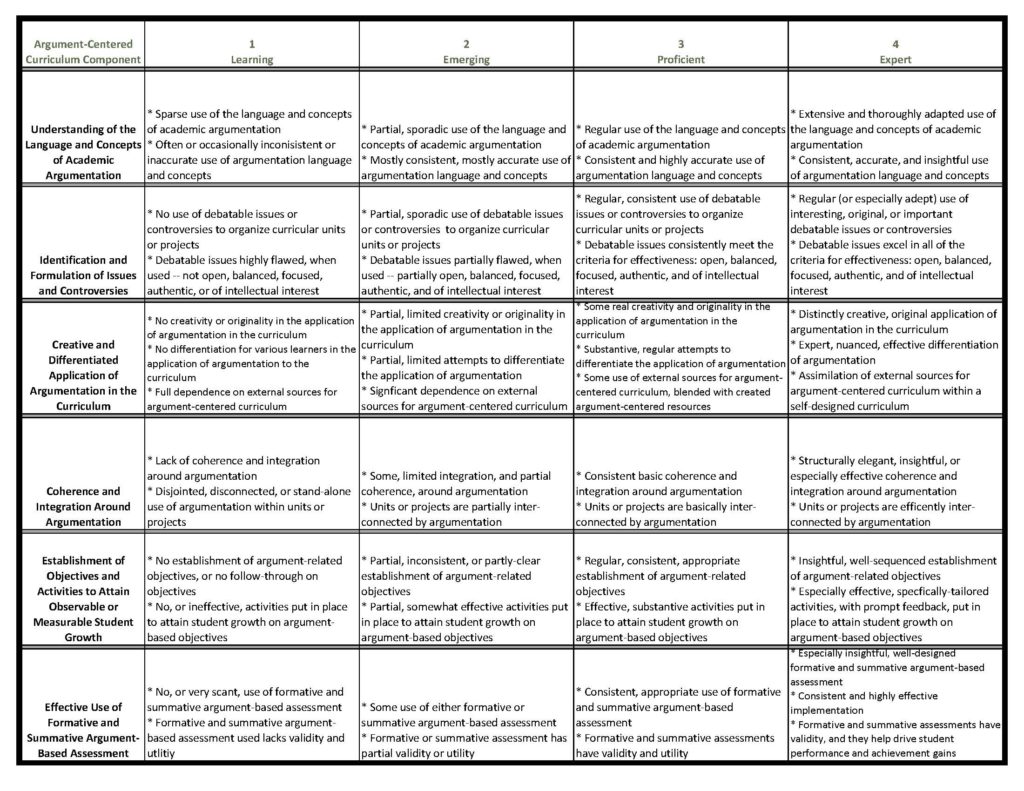
Introducing the Observation of Argument-Centered Instructional Capacity Inventory, Part 1
Overview
About five years ago, when we got started with the work we are doing now – first calling it curricular debate, then argument-centered instruction – partner school teachers and administrators asked us two simple but important questions: what are the specific professional capacities that Argument-Centered Education will develop and how will we know that they have, indeed, developed? We undertook the kind of inquiry-driven, analytical process that we try to build into the curriculum that we design with partners on our own argument pedagogy, and we produced the Observation of Argument-Centered Instructional Capacity (OACIC) Inventory.
This instrument disaggregates argument pedagogy into three domains and eighteen components. The organization of the three domains – curriculum, instruction, and culture – and several of the components were influenced were influenced by Charlotte Danielson’s framework for teacher evaluation (Danielson 2011), though this protocol falls on the development/measuring dichotomy that Robert Marzano has posited for teacher professional capacity instruments (Marzano 2012). The OACIC Protocol is now in use with all of our partners, but for none of them is it a way to formally evaluate teachers.
Instead, the OACIC Inventory is an instrument with several other important purposes. It enables teachers to understand what they need to know how to do in order to achieve rigorous, engaging, and college-directed instruction consistently in all of their classes. It identifies areas of professional capacity that are already well developed and can be leveraged, or that are moderate or low and can be grown and further developed. It can also measure the professional capacity growth that takes place over a year, or multiple years. And it provides administrators with insights into all of these crucial aspects of the work that their teachers are undertaking at the heart of their middle and secondary schools’ mission: authentic college readiness for all of their students.
A word on how and when the OACIC Inventory is completed. Administrators at partner schools of Argument-Centered Education have often used it in combination with other instruments they use to provide feedback to their teachers. We typically use the Inventory to provide an inventory of teacher capacities early in the school year and again late in the school year, sitting down with teachers to discuss their reflections on their own capacity growth during the school year. Taking heed of advice of researchers on teacher development and evaluation systems, we base our completion of the Inventory on numerous classroom visits and observations, sometimes as many as 10 – 15. Teachers are encouraged to self-inventory their capacities, as well, both early and late in the year, which is particularly important to having de-brief and reflection discussions.
We’ll look now at the Observation of Argument-Centered Instructional Capacity (OACIC) Inventory in detail, examining some of the salient thinking within each of the three domains (Curriculum, Instruction, and Culture), and the utility of the form. And as we look more closely at each of the items in each of the domains, one idea that may occur is how demanding and stringent this Protocol can seem. We can take this as a reminder that great teaching is very, very difficult to do. Its difficulty and its value are commensurate. At the same time, the OACIC Inventory lays out an idealized, aspirational set of capacities for teaching with academic argument and critical thinking at the center. No teacher (yet, in our experience) has demonstrated “expert” capacity on every item in all three domains, but every teacher can use the Protocol to move up the scale of professional skillfulness.
Curriculum

Both the Curriculum and Instruction domains include “the language and concepts of academic argumentation.” For their curriculum, teachers should attempt to use this language and its underlying concepts extensively and in a thoroughly adapted way to what they are teaching. This is another way to say that teachers should deploy argument terms and ideas to ensure that students are thinking critically throughout their curriculum. Teachers should also use the language and concepts of academic argumentation accurately and (eventually) with their own insights (which might include explaining how the fundamental concepts of argument are named differently by different argument theorists and models).
The generative role of the debatable issue should be reflected in a teacher’s curriculum. Debatable issues are deceptively difficult to get right, and the Curriculum domain points to the key criteria for their effectiveness: openness, balance, focus, authenticity, and intellectual interest.
Creativity and differentiation are combined in an item in the Curriculum. Teachers should work to differentiate their argument-centered curriculum, to meet the needs and serve the levels of each student they teach, including the use of techniques Argument-Centered Education offers. Creativity is an often under-appreciated attribute in effective curriculum. Integrating argument into content throughout a course should be done from a position of open, original thought, and possibility rather than prescription. Building argument and critical thinking into content is ab important opportunity for originality in the teaching profession, and the best teachers take a lot of advantage of this.
Coherence is another quality of effective curriculum that is sometimes not thought about directly or incorporated with intentionality. When argument-centered curriculum is fully coherent, each of its pieces has a relationship to each other and a place within study of the debatable issues overall. Expressing it this way comes fluidly, and this sounds straightforward enough, but coherence is a design element that is achieved only through rigor and intention. With it, curriculum falls together, flows, mutually reinforces, and makes sense. Perhaps the most challenging aspect of an argument-centered unit to make fully cohere with the rest is when information (content) is being taught that will later form the basis of students’ arguments on the unit’s debatable questions. It takes subtle skill to organize this instruction in relation to arguments, while staying true to the full content demands of the unit and without overly schematizing instruction and pre-empting students’ open response to what they are newly learning.
Well designed curriculum will necessarily include grade level normed, thoughtfully sequenced, carefully calibrated and focused objectives for the demonstrated understanding of academic argumentation skills, as they appear in the specific subject area. The objectives for a unit established before a semester begins can be adapted or amended as teachers learn more about what their students have learned and where they can best grow next, but a unit should always begin with the right objectives. But, of course, objectives are only as useful as their instruction is aligned. So well designed curriculum will have activities that are specifically tailored, with a mechanism for prompt feedback given to students on their progress toward achieving the objectives.
Similarly, formative and summative assessments should be used at appropriate times during the unit, and their use should have validity – in relation to content being studied, to argumentation objectives, to the coherence of the unit as a whole.

With this Overview and an exploration of the Curriculum domain, we will close the first part of the introduction to the Observation of Argument-Centered Instructional Capacity (OACIC) Inventory. In Part 2, we will explore the Instruction and Curriculum domains, and discuss the utility of the Form included in the Inventory.
Part 2 of this introduction to the OACIC Inventory has been posted here. Part 2 explores the domains of Instruction and Culture in some detail, and discusses the use of the Inventory Form.
References
Danielson, Charlotte. The Framework for Teacher Evaluation Instrument. Danielson
Group, 2011.
Marshall, Kim. “Fine-Tuning Teacher Evaluation.” Educational Leadership. Vol. 70,
No. 3. November, 2012.
Marzano, Robert. “The Two Purposes of Teacher Evaluation.” Educational
Leadership. Vol. 70, No. 3. November, 2012.

